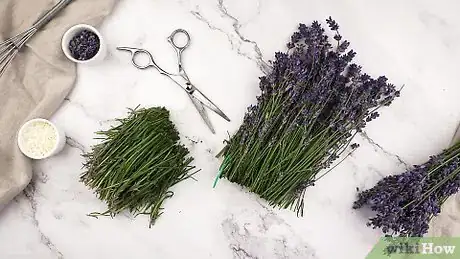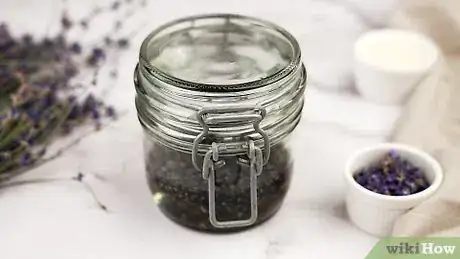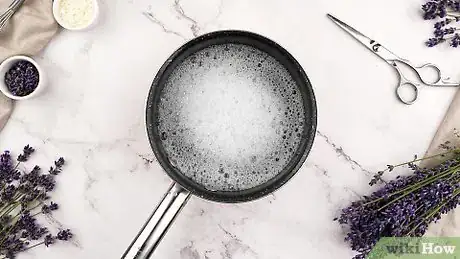This article was co-authored by Julie Brow-Polanco. Julie Brow-Polanco is a Master Herbalist & Certified Aromatherapist with more than 11 years of experience. She is an expert on natural remedies and specializes in using them to support whole-body wellness, particularly immune, digestive, nervous, and reproductive health. Julie earned a Bachelor's Degree in Psychology from Dominican University, a Master Herbalist Certification from The School of Natural Healing, and a Certificate of Aromatherapy from the Pacific Institute of Aromatherapy. Julie is a member of the American Herbalist Guild and a Certified Aromatherapist through the National Association of Holistic Aromatherapy.
There are 9 references cited in this article, which can be found at the bottom of the page.
wikiHow marks an article as reader-approved once it receives enough positive feedback. This article has 40 testimonials from our readers, earning it our reader-approved status.
This article has been viewed 1,396,411 times.
Long loved for its delightful fragrance and beauty, lavender oil may also be used to soothe injured or itchy skin, aid sleep, or simply create a pleasant massage oil.[1] The lavender-infused oil or balm below are excellent choices for home recipes, as they are easy to make, can be used with any amount of lavender, and result in a ready-to-use product. You may choose to make a lavender essential oil instead, but be aware that the process can be difficult, and results in a much smaller quantity of highly concentrated oil that may need to be placed in another oil anyway before use.
Steps
Making Lavender-Infused Oil
-
1Cut sprigs of fresh lavender or purchase them dried. Cut off the stems of lavender along with the flowers, in 6 inch (15 centimeter) segments or longer. The leaves and new stems can be used to infuse oil as well as the flowers, although the woody, thick stems near the base should be avoided.[2] You may use flower buds or strong-smelling flowers.[3]
- You may wish to pick more lavender than you think you need. Then, if the oil you create isn't strong enough to suit your preferences, you will not have to wait for a new batch of lavender to dry.
-
2Let the lavender dry. If you are using fresh lavender, dry it first in shade or wrapped in a cloth, to enhance its aroma and minimize the chance of the oil becoming rancid. Tie the sprig up with rubber bands or a string and let it hang upside down in a dry, warm area. Exposing it to sunlight will dry the lavender out much faster, but could break down some of its aromatic oils. Fresh cut lavender may take two weeks to dry fully. Some infusers dry it for only one to three days, until it is withered but not crunchy; this reduces the chance of spoilage greatly, but does not eliminate it.[4]Advertisement
-
3Lightly crush the lavender and place it in a jar. Crumble the lavender apart with clean hands, or bruise it slightly with any clean, heavy object to expose its fragrance. If using buds, open them up with a knife or fingers. Place it in a clean jar.
- Wash your hands and jar first if they are dirty, but dry thoroughly before bringing them into contact with the lavender. Mixing water into the oil may interfere with the infusion.[5]
-
4Pour oil over the flowers. Pour any non-scented or lightly scented oil into the jar, fully covering the lavender but leaving 1–2 inches (1.25–2.5cm) of space at the top to allow for expansion.[6] Almond oil, olive oil, or safflower oil are commonly used for this purpose, although you may wish to smell these first and avoid strong-smelling bottles that could overpower the lavender scent.
-
5Soak the lavender if you have time and sunlight. Cover the jar tightly and leave the mixture to soak in a sunny location. It will most likely take at least 48 hours to achieve a noticeable scent, and more typically the oil is left out for three to six weeks. If you do not have enough sunlight or time to use this method, continue to the next step.
-
6If you do not have time or sunlight, heat the oil carefully. A faster alternative to the sun-steeping method is to heat the oil and lavender mixture in a double boiler or crockpot for 2–5 hours, keeping it at a steady temperature between 100–120ºF (38–49ºC). This is only recommended if you have a cooking thermometer and a well-controlled, low temperature heat source, as too much heat can affect the aroma and the shelf life of the oil.[7]
-
7Strain the oil. Lay a piece of muslin or cheesecloth over a bowl and pour the oil and herb mix over it. Discard the flowers and other lavender pieces in the compost or garden.
-
8Repeat the process if you wish to make the oil stronger. The same oil can be poured back into the jar and have a new batch of dried lavender placed in it. As described above, leave it out in a sunny location, or heat it at low temperatures, to create a stronger infusion. This can be repeated as many as eight times if you want a powerful oil.[8]
-
9Add a few drops of vitamin E (optional). Vitamin E can be added at the end of the infusion to increase the shelf life of the oil. This is recommended if you do not have a cool, dark place to store the oil, or if the oil you used is somewhat old or has a short shelf life. Stir in a few drops of vitamin E oil, or cut open a vitamin E gel capsule and pour in the contents.
-
10Store your oil in a dark bottle or jar. Gather up the muslin and squeeze the material to extract as much as you can over a bowl or measuring cup. Transfer this to a bottle or jar made from dark glass or opaque plastic to prevent overlong exposure to light from breaking the aroma down. The shelf life for lavender infused oil depends on the type and freshness of oil used, but can typically last for months if kept in a dry, dark location.
Creating Lavender Balm or Salve
-
1Follow the instructions for creating an infused oil first. This method turns a lavender-infused oil into a salve that can be rubbed onto your skin to lessen inflammation and pain.[9] First, you'll need to create the lavender-infused oil as described in another section, or purchase some from a herbalist store.
-
2Shave beeswax using a knife or cheese grater. You may wish to use a cheap, extra grater rather than one you use regularly, because the wax may be difficult to clean off. Measure the beeswax before you shave it into fragments; you will need approximately 1 part beeswax to 8 parts oil. Use more beeswax for a harder balm, and less for a softer salve.[10]
- If your beeswax was sold by weight, you can use these approximate weight to volume conversions: 1 ounce of beeswax = 1 fluid-ounce (29.6 ml) = 1/8 cup = 28 grams.[11]
-
3Heat the beeswax and oil over low heat. Place the beeswax fragments in a pan. Pour the lavender-infused oil over it. Heat over low heat until they have melted together. It may take 15 minutes or more for all the beeswax fragments to melt. Stir occasionally using a wooden spoon or other heat-safe utensil, preferably one you don't mind damaging if wax ends up stuck to it permanently.
-
4Pour the mixture into containers. Pour the melted balm into glass or tin containers, making sure they are clean and dry first. Seal with an airtight lid.
-
5Harden the mixture in a cool location. After 10 or 15 minutes in the refrigerator, or 30 minutes in a cool room or cellar, check on the balm or salve to see how hard it is. If it is still liquid, or too hard to scoop up with your fingers, you may need to melt it again. Add more beeswax to make it harder, or more oil to make it softer.
-
6Clean your pot and stirring utensil. Boil hot, soapy water in your pot once it's been emptied of balm, then turn off the heat. Let it cool for a couple minutes, then put on rubber gloves so you can scrub the wax from the sides while the water is still quite hot. Place the stirring utensil in the water only after the water is done boiling to avoid damaging it. Scrub the utensil and pot with a hard sponge or scrubbing brush.
Expert Q&A
-
QuestionHow can you use lavender to freshen up your home?
 Julie Brow-PolancoJulie Brow-Polanco is a Master Herbalist & Certified Aromatherapist with more than 11 years of experience. She is an expert on natural remedies and specializes in using them to support whole-body wellness, particularly immune, digestive, nervous, and reproductive health. Julie earned a Bachelor's Degree in Psychology from Dominican University, a Master Herbalist Certification from The School of Natural Healing, and a Certificate of Aromatherapy from the Pacific Institute of Aromatherapy. Julie is a member of the American Herbalist Guild and a Certified Aromatherapist through the National Association of Holistic Aromatherapy.
Julie Brow-PolancoJulie Brow-Polanco is a Master Herbalist & Certified Aromatherapist with more than 11 years of experience. She is an expert on natural remedies and specializes in using them to support whole-body wellness, particularly immune, digestive, nervous, and reproductive health. Julie earned a Bachelor's Degree in Psychology from Dominican University, a Master Herbalist Certification from The School of Natural Healing, and a Certificate of Aromatherapy from the Pacific Institute of Aromatherapy. Julie is a member of the American Herbalist Guild and a Certified Aromatherapist through the National Association of Holistic Aromatherapy.
Master Herbalist & Certified Aromatherapist You can use dried flowers to make little sachets that you can add to your laundry. You can also use essential oil in a room diffuser to make your whole house smell nice. There are stick-type room candles where you have the oil in the bottom and it flows up the stick. That's a much slower release.
You can use dried flowers to make little sachets that you can add to your laundry. You can also use essential oil in a room diffuser to make your whole house smell nice. There are stick-type room candles where you have the oil in the bottom and it flows up the stick. That's a much slower release.
Warnings
- Do not leave wax or oil unattended on the stovetop. It may smoke or catch fire if the temperature gets too high.⧼thumbs_response⧽
- One study suggested that repeated topical use of lavender oil may cause prepubertal gynecomastia in some males who have not reached puberty; this condition make boys grow extra breast tissue.[13]⧼thumbs_response⧽
Things You'll Need
Infused oil:
- Lavender buds, flowers, or leaves (or all three)
- A wide-necked jar with tight-fitting lid
- Any oil without a strong scent (enough oil to cover the lavender)
- Sunlight or double boiler or crockpot
- Bowl
- Muslin or cheesecloth
- Dark glass bottle with tight-fitting lid or stopper
Balm:
- Infused oil
- Beeswax
- Pot or pan
- Stirring utensil
- Jars or tin containers with tight lids
References
- ↑ http://www.ncbi.nlm.nih.gov/pubmed/22809036
- ↑ http://everything-lavender.com/how-to-make-lavender-oil.html
- ↑ http://www.anniesremedy.com/chart_remedy.php?rem_ID=143
- ↑ http://www.rareplantnursery.net/how-to.html
- ↑ http://herbalacademyofne.com/2013/05/herb-infused-oils/
- ↑ http://www.anniesremedy.com/chart_remedy.php?rem_ID=143
- ↑ http://www.rareplantnursery.net/how-to.html
- ↑ http://www.offthegridnews.com/2012/04/09/how-to-make-your-own-essential-oils-and-perfumes/
- ↑ http://www.ncbi.nlm.nih.gov/pubmed/22809036
About This Article
To make lavender-infused oil, buy sprigs of dried lavender or collect fresh sprigs and dry them. Lightly crush the lavender flowers with clean, dry hands and place them in a small jar. Pour an oil such as almond, olive, or safflower oil over the flowers, leaving 1-2 inches (2.5-5 cm) of space at the top of the jar. Close the lid tightly and place the jar in a sunny spot for at least 48 hours. Lay a piece of muslin or cheesecloth over the top of a bowl or jar and strain the oil through it to remove the dried lavender pieces. If you want, put new lavender flowers in the same batch of oil and repeat the process to make a stronger infusion. Put the oil in a dark, tightly sealed bottle or jar and store it in a cool, dark location. If you want to learn how to make a lavender balm with beeswax, keep reading!


































































